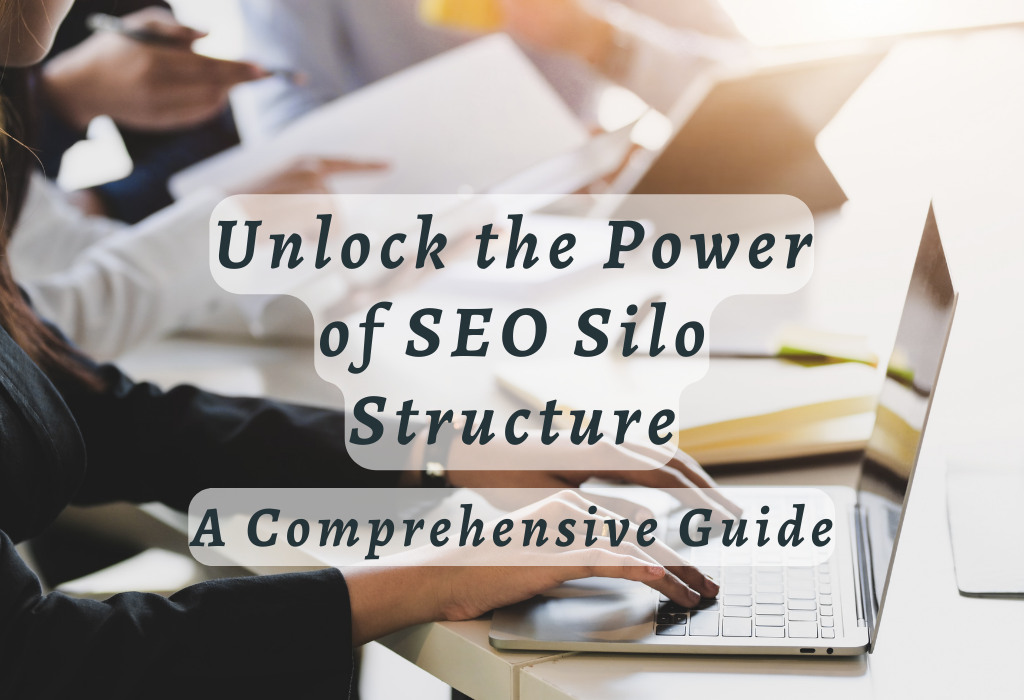Unlock the Power of SEO Silo Structure: A Comprehensive Guide
As a marketer, you know the importance of optimizing your website for search engine visibility. But do you understand how to use an SEO Silo Structure?
In this article, we will discuss what a silo structure is, its advantages over flat structures, the types of silos available, how they can be implemented on websites, and some auditing tools. We’ll also examine the pros and cons of employing an SEO silo structure for improved organic rankings.

What is a Silo Structure?
A silo structure is an organizational method used in digital marketing to group related content. It helps search engines understand the relationship between different pieces of content and how they are connected. By organizing content into silos, marketers can ensure their website’s SEO efforts are more effective.
Benefits of Silo Structure
Silo structures help create a hierarchy on a website so that each page has its place within the overall site architecture. This makes it easier for search engine crawlers to index and rank pages based on relevance and importance.
The structure also allows for better internal linking, which can improve user experience by giving visitors easy access to related topics from any page on the site.
Types Of Silo Structure
Several types of silo structures are available, including top-down recycle, reverse, serial, YOLO (you only link once), and priority silos. Each type has advantages depending on what kind of content is being organized or how much control over internal linking is desired by the marketer or webmaster.
In conclusion, understanding how a proper Silo Structure works can greatly benefit your website’s SEO efforts if implemented correctly using one or more of the abovementioned techniques depending on your needs. With this knowledge, you can ensure that your site’s content is organized efficiently while helping to boost rankings in SERPs (Search Engine Results Pages).
Flat Structure vs Silo Structure
Flat Structure vs Silo Structure is an important topic for marketers to understand.
Flat Structure
A flat structure is one where all content is organized in a single layer, with no hierarchy or organization. This can be effective for smaller websites, but it can make it difficult for search engines to understand the relationships between different pieces of content.
Silo Structure
A silo structure organizes content into related topics and subtopics, making it easier for search engines to understand their connections.
For example, if you have a website about cars, your silo structure might look like this: Cars > Makes & Models > Reviews > Accessories > Maintenance Tips etc. This makes it easy for search engine crawlers to find relevant information quickly and easily.

Ways To Implement Silo Structure
There are several ways that you can implement a silo structure on your website, including virtual silos (using tags/categories), physical silos (using folders/directories), URL structures (using keywords) and link structures (linking related pages together).
When implementing any siloing strategy, you must keep things consistent throughout the entire website to avoid confusing users and search engine crawlers.
When auditing existing websites, several tools are available such as Screaming Frog SEO Spider, which allows users to crawl their sites by looking at URLs, titles, meta descriptions etc., giving them insight into how their current site architecture looks from an SEO perspective.
Additionally, other tools such as Ahrefs Site Explorer allow users to analyze backlinks pointing towards their domain, helping them identify potential issues with their link profile or opportunities for improvement depending on the results they’re aiming for from the audit process.
Disadvantages Of Silo Structure
It is worth noting that while using a Silo Structure has many advantages, there are also some disadvantages associated with this approach.
Most notably, if done incorrectly, it could lead to duplicate content issues due to its hierarchical nature – something Google does not approve of – so care should be taken when setting up any Siloing strategy on any website.
The silo structure offers more benefits for SEO than the flat structure, so it is worth considering when optimizing your website for search engine rankings.
How Silo Structures Improve Website SEO?
Let us begin with a definition. Silo structure optimization entails categorizing and optimizing your website pages based on their content. You must do two things to optimize your content for the Silo structure:
It can be not easy at times, especially if you have many articles and landing pages covering a wide range of topics. There is, however, a way out. You can use Google Analytics or Search Console to analyze your website, define the main keywords for which it ranks, and discover which topics attract the most traffic.
To begin with, the proper Silo website structure facilitates and accelerates the search process on your website and aids in full indexing by search robots without any obstacles.
In this manner, you assist users in easily navigating your website and finding any information they require when search algorithms, in turn, understand your website’s structure and easily form a list of tasks for website crawling.
Assume your website structure is logical, with a semantic hierarchy. In that case, it’s much easier to distribute static weight among pages and use anchor text on referring pages while maintaining content thematic coherence.
You have two options: physical or virtual. With physical Silo optimization, you must manually create your website’s URL structure.
Virtual Silo optimization is grouping your website’s categories using HTML internal linking. It makes no difference which type of Silo optimization you use; the main goal is to group similar and separate unrelated content.
Because Silos contain groups of content related to a single topic, the internal links between pages within them are contextually linked. Siloing is creating internal links to and from pages (with relevant anchors) that focus on the same topic. It assists Google in understanding your page architecture and the value it will provide to users.
Siloing your website creates a logical hierarchical structure with consistent internal linking and relevant keywords. As a result, each of your Landing pages is optimized with the appropriate number of keywords related to a specific topic. It assists you in avoiding keyword stuffing and incorporating relevant long-tail keywords into your website.

The main point of the Silo structure is that each silo includes an interlinked main silo page that is related to the content of the silo. However, it is important to understand that content in one silo should not interact with content in another silo; in other words, this content is “isolated” in these silos.
What effect does it have on your website’s ranking? The solution is straightforward. If you have a page dedicated to a specific topic linked to pages with supporting content, search engines will consider you an expert in that topic and rank your website higher.
SEO Silo Structure Example (Top-Down Recycle, Reverse, Serial, YOLO, Priority Silo)
Top-Down Recycle (TDR)
This silo structure is ideal for websites with large amounts of content. It organises the content into a hierarchical structure from top to bottom. The main page is at the top, and each subsequent page links back to it in a cycle.
This helps search engines better understand how your website’s pages are related and makes it easier for them to crawl through your site.
Reverse Silos (RS)
Reverse silos work similarly to TDR, but instead of linking back up in a cycle, they link down in reverse order. This means the main page is at the bottom, and each subsequent page links up towards it instead of down, like with TDR structures.
This can be useful if you want certain pages or sections on your website to have more prominence than others, as they will appear higher on search engine results pages (SERPs).
Serial Silos (SS)
Serial silos involve creating multiple layers within one category or topic area on your website so that all related content appears together when searched online.
For example, if you had an e-commerce store selling shoes, then you could create separate categories such as “Men’s Shoes” and “Women’s Shoes”, which would both contain their subcategories such as “Running Shoes” or “Dress Shoes”.
YOLO Silos (YS)
YOLO stands for “You Only Link Out”, meaning that this type of silo only has outbound links from its main page leading directly to other websites without any internal linking between its pages.
While this isn’t necessarily beneficial for SEO purposes since there’s no way for search engines to crawl through all the linked sites, it can still be useful if you’re looking to promote external sources quickly and easily while keeping users engaged on your website due to lack of internal navigation options available elsewhere.
Priority Silos
Priority silos are similar to serial silos, except they prioritize certain topics over others based on what is most important, relevant or popular. This allows the associated webpages of those topics greater visibility when searched online compared with less relevant ones further down in hierarchy order, even though they may share similar keywords or phrases in their titles and URLs.
For instance, if someone searches for “shoes”, then priority ranking might mean that Men’s Running Shoes appear before Women’s Dress Shoes despite having ‘shoes’ included somewhere within their title tags.
How to Silo a Website (Virtual, Physical, URL, Link)?
Siloing a website is an important part of SEO and content marketing. It involves creating structures within your website that link related pieces of content together. This can be done through URLs or links that point from one page to another or by creating categories and tags that similarly group pieces of content.
Virtual Silo Structure
A virtual silo structure is created when you create internal links between pages on your site using anchor text keywords relevant to the topic.
For example, if you have a blog post about “How To Start A Business”, you could link to other blog posts about business topics such as “Business Financing Options” or “Business Planning Tips” with anchor text like “business financing options” and “business planning tips” respectively.
This creates a virtual silo structure for those topics on your site, which makes it easier for search engines to understand what each page is about and how they are related.
Physical Silo Structure
A physical silo structure involves organizing webpages into distinct categories based on their subject matter so they can be easily found by visitors browsing the site.
For example, if you had a blog post about starting a business, it would make sense to place this in the category labelled “Business” rather than in the category labelled “Recipes”.
This helps visitors find information quickly without searching through unrelated pages before finding what they need.
URL & Link Silos
URL & Link silos involve linking from one page on your website directly to another, which contains more detailed information about the same topic.
For example, if you had an article titled “Starting Your Own Business”, you could link directly from this article’s URL (www.examplewebsite/starting-your-own-business)to another article titled “Writing Your Business Plan”.
Doing this will help users navigate your website more easily while also providing additional value since they won’t have to search elsewhere for more detailed information related to their query.
Website Silo Structure Auditing Tools
Website Silo Structure Auditing Tools are essential for marketers looking to maximize their SEO performance. By auditing your website’s silo structure, you can identify any areas where improvements could be made and ensure that your content is organized to maximise its visibility and search engine rankings.
It is one of the most popular tools for website silo structure auditing. It crawls websites quickly and efficiently, allowing you to analyze the structure of each page on your site and identify any issues with internal linking or other structural elements that may be hindering your SEO efforts.

It is another great option for website silo structure auditing. This tool offers comprehensive insights into how well-structured each page on your site is, including metrics such as keyword density, heading tags, meta descriptions, alt text optimization and more.
With this information, you can make informed decisions about optimising the content on each page for maximum visibility in search engines.

It also provides valuable insights into the overall health of a website’s silo structure by analyzing factors such as broken links, redirect chains and duplicate content issues which can all impact a site’s ranking potential if not addressed properly.
Additionally, it allows users to track changes over time to monitor progress towards their desired goals effectively.

Finally, there are several other tools available specifically designed for website silos, such as Top-Down recycling (TDR), Reverse Silos (RS), Serial Silos (SS), YOLO Silos (YS) and Priority Silos (PS). Each of these structures has its unique advantages when it comes to optimizing content within them. Still, ultimately it will depend upon individual requirements when deciding which type would work best for a particular project or campaign goal.
Website silo structure auditing tools can help marketers better understand how their website is organized and identify areas for improvement.
FAQs About SEO Silo Structure
Conclusion
In conclusion, an SEO silo structure is a great way to organize your website for better search engine optimization. It helps you create an organized hierarchy of content that can be easily crawled and indexed by search engines.
By creating virtual, physical, URL and link silos on your website, you can improve the visibility of your pages in SERPs and increase organic traffic. Additionally, using auditing tools to audit the silo structure of your website will help ensure that it is optimized correctly for maximum SEO benefit.
Are you looking for an effective way to improve your content marketing and SEO strategy? Curationsoft.com offers the perfect solution – our comprehensive SEO Silo Structure! This advanced system organizes your website’s pages into distinct, related categories that help search engines identify what each page is about, making it easier to rank higher in SERPs.
Our experienced team will work with you every step of the way to ensure maximum success with this powerful tool. Don’t wait any longer – contact us today and take advantage of our expert advice on implementing a successful silo structure!






